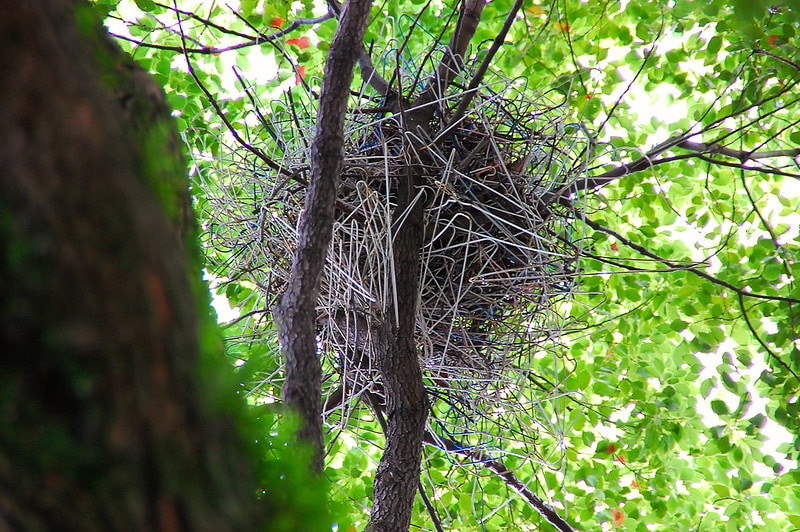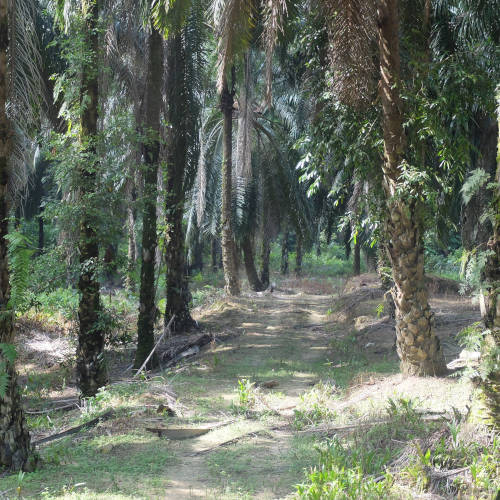“yeʔ kan plŋal!” “lawac!” “hɛy yeʔ leh!”
“Don’t laugh!”, “It’s taboo!”, “We shouldn’t!”
Naʔ Srimjam kept admonishing us one afternoon that she, her sister Naʔ Badək, and I, spent making hair decorations in the forest. As the three of us sat cutting leaves into fine swirls, the sisters asked me to film them singing songs from their teenage days, as the act of making the decorations fondly reminded them of those times. But every time Naʔ Srimjam got to a certain part of the song, Naʔ Badək would make her laugh by giving her a funny look, and each of us would break down into tears of giggles. Though Naʔ Srimjam chided that we were being taboo and to stop laughing, prompting us to calm down enough for her to start singing again, she would immediately burst out laughing once more as soon as she locked eyes with her sister, and so the cycle of tabooed laughter continued. Knowing they shouldn’t be making each other laugh only made the situation funnier.
The Batek are a hunting and gathering group, numbering around 1,500 people across the Peninsular Malaysian states of Pahang, Terengganu and Kelantan. I conducted 18 months of fieldwork with Batek De’ speaking groups in Pahang. Batek people have many taboos on laughter, which are referred to as the lawac taboos. In and of itself, laughter that is too loud or goes on for too long is lawac. It’s also particularly lawac to laugh in certain situations, to mix the bloods of certain animals, to mix certain smells or bloods, or have incestuous relations. Laughing around particular non-human entities, such as leeches, millipedes, worms, lice, or monitor lizards is particularly lawac. These lawac actions risk upsetting the thunder-being, Gubar, who then causes thunder storms that are greatly feared and potentially fatal.
The two sisters, like most others, generally take the lawac taboos seriously, expressing adherence to them in ethical terms whereby adherence is ‘right’ and ‘good’ (btʔɛt), and failing to adhere is ‘bad’ and ‘wrong’ (jbʔec). In everyday discourse, adhering to the taboos is considered a sign of a well-adjusted person who understands how to ensure good relations between people and the diverse other entities of the forest through shaping their own behaviour.
In and of itself, laughter that is too loud or goes on for too long is lawac. It’s also particularly lawac to laugh in certain situations, to mix the bloods of certain animals, to mix certain smells or bloods, or have incestuous relations.
Expressed by them in terms of their behaviour being both jbec (‘bad, wrong, ugly’), and lawac (‘taboo’), the sisters’ laughter that day constituted what in English might be described as a failure; to adhere to the taboo, and to coordinate with the desires of Gubar. Though that time we got away with it, as Gubar didn’t notice and there was no storm, the act of laughing had the potential for dangerous ramifications. Why, then, would the sisters be laughing at the silliness of that day in the forest, when they knew the laughter was lawac? Why would they potentially cause the relationship between themselves and Gubar to break down – with dangerous consequences? In that instance, the knowing silliness and intimacy of the laughter was simply too seductively, subversively pleasurable for them to avoid.
Such moments of laughter can be thought of as relational encounters that demonstrate the ‘friction’ of interactions across difference (Tsing 2005). Gubar (the thunder-being), by contrast to Naʔ Badək and Naʔ Srimjam, is ‘different’: he has a divergent understanding of what the meaning of laughter is, what the meaning of it might have been in that moment of shared intimacy between the sisters, and of how to respond to it. He is more likely to be angry at laughter, and offended that Batek aren’t adhering to what he sees as ‘the old ways’ of following the taboos. Yet in turn, it was the very fact of his different sensibility to the world that continued to make the sisters’ laughter so hilariously subversive.
People’s ideals might well be to avoid the friction caused by ‘failure’ by adhering to the lawac taboos, and thus doing the ‘right’ thing that doesn’t upset others. Yet in reality, in the intimacy of day-to-day life, a level of friction between ‘different’ persons is inevitable – such as when people are seduced by situations that become all the funnier as soon as someone says ‘don’t laugh’.
This friction is exacerbated by laughter, as it is so difficult to pin down: its meanings are ambiguous, it can erupt unexpectedly, be physically and bodily impossible to control, and therefore create the possibility for misinterpretation, confusion, and offence. Any instance of laughter might be funny to some, but anger-inducing to others. This inevitably causes relationships to fail, particularly when one is surrounded by sentient other-than-human persons such as Gubar, for whom mistakes and misinterpretations can potentially lead to dangerous storms, and by flowers and fruits, around whom laughter can cause offence to the fruit season – stopping fruits from ripening that year.
Human and non-human hunters (such as tigers) often trick their prey by imitating their calls to lure them closer, exploiting this capacity for failure.
Just as people might ‘get it wrong’ by failing to control their laughter, so too might nonhuman entities sometimes fail. In the Batek’s forest, certain birds often indicate events. The wãl bird, for example, tells that a newborn baby has been born as it imitates the wãl wãl wãl sound of a crying infant. But one always has to bear in mind that hearing its call might not always mean that a baby has been born, as the bird, like humans, has the capacity to misinterpret, to get it wrong. Human and non-human hunters (such as tigers) often trick their prey by imitating their calls to lure them closer, exploiting this capacity for failure. Similarly, despite it being Gubar’s sensitivities that mean the Batek must control their own laughter, sometimes Gubar too might fail, such as on that day when he just didn’t notice that the sisters were laughing.

It can also be difficult for Batek people to interpret Gubar, to tell who or what is causing his anger. This is not just at the level of which Batek person may have been the cause of the wrongdoing: sometimes Gubar’s storms are nothing at all to do with the Batek. Perhaps Gubar is getting angry at flowers, telling them to hurry up and bloom. Again, the ambiguities in how laughter and storms might be interpreted among diverse persons mean that the temptation to allow yourself to laugh is high: maybe Gubar won’t notice? Or, if he does notice, perhaps the consequent storm wasn’t your fault anyway but the fault of the flowers?
This leaves plenty of space for friction to occur. Different persons are sensitive to the world in different ways. With laughter in particular – as it often emerges spontaneously and uncontrollably – the friction thus caused becomes part of day-to-day life. Part of being a sentient, intentional person among these multispecies entanglements – whether you are human, non-human animal, plant, or thunder-being – is making mistakes. Just as you may misinterpret others’ actions, your own actions – laughter or other – may in turn be misinterpreted by others. Perhaps, even, to your advantage.
Different persons are sensitive to the world in different ways. With laughter in particular – as it often emerges spontaneously and uncontrollably – the friction thus caused becomes part of day-to-day life
There is thus fluidity here between culpable and inculpable failures. The ambiguity of who can be considered the agent of failures and their consequences, in combination with the inevitability of failure across difference, means that culpability for wrongdoing is dispersed. This is an important part of coexistence within this multispecies context.
In their consideration of ‘how things hold’, Gan and Tsing have focused on multispecies ecosystems to argue that co-ordination between species is critical for their co-existence. They point to the importance of the ‘accidental’ synchronies that make up interspecies ‘co-ordination’ (Gan and Tsing 2018). To understand how multispecies assemblages hold together, they argue for tracing the complexities of these co-ordinations.
But in the multispecies assemblage that is the Batek’s forest, the diverse persons who constitute it often also fail to co-ordinate with one another. The shared and oft-articulated knowledge – for example regarding taboos on laughter – mean that people know how they should act in order to ensure co-ordination. Yet, the realities of being alive mean one can’t always adhere to these demands. There is always the potential for failure despite best-laid intentions.
Given this, it is important to add nuance to the idea that the multispecies assemblages inhabited by hunter-gatherers are constituted relationally among members who dwell ‘with’, or ‘become with’, one another, in a co-ordinated fashion (Haraway 2008). While this may often be true, persons also sometimes make mistakes that knowingly upset others, and as such are not co-ordinated ‘with’.
It is important to question more closely what it means to be ‘with’ in the immediacy of everyday life. Often, acceptance of the inevitability of failure, and the consequent potential for the breakdown of relationships, is as woven into the fabric of everyday multispecies coexistence as coordination. There is always the chance for offence, anger, or danger in interspecies interactions. Trying to coordinate oneself with diverse others, but sometimes inevitably making mistakes or throwing caution to the wind, becomes part of what it means to live ‘with’.
For Batek people it doesn’t matter if you laugh at oil palms.
This breakdown that is central to how diverse living persons end up living ‘with’ one another is thrown into sharp relief by the oil palm plantations that neighbour Batek forests, on which many Batek people labour. In contrast to the forest, those who design plantation environments seek to banish diversity through their use of regimented, mono-cropped plantations (Tsing 2017). But not only are harmoniously plural interspecies coordinations seemingly banished, but so too are their divergences – their potential failures to align. In plantation spaces, failures of co-ordination cost profit.
This is a far cry from the forest, where getting it wrong is an inevitable part of multispecies life. Reflecting this, though laughter at around certain forest plants affects the fruit season and causes offence, for Batek people it doesn’t matter if you laugh at oil palms. Unlike many forest entities, these palms are not sentient persons, raising questions about the kinds of interspecies relationships that become possible. What might failure look like here, and who becomes culpable?
Attention to the spaces of miscommunication and divergence where things don’t hold can thus aid understanding of the forms of coexistence that are erased by capitalist expansion. But it might also offer new potentials for understanding the kinds of coordinations and mis-coordinations between species that people experience at the margins of these plantation environments.
Reclaiming the potential for the failure when living among others is therefore important. It offers a challenge to the romanticising idea that indigenous peoples inhabit multispecies worlds that are somehow more relational, or more spontaneously co-ordinated than capitalist or ‘Western’ ones. But it might also offer the opportunity to better understand the gaps – the failures – that might be left by nefarious plantation ecologies. Multispecies assemblages are not only easily definable, coherent wholes. In many contexts, co-existence is dangerous, and lives can conflict, jostle, or be exploited. Failures – for example laughing when you shouldn’t – become a part of what it is to live among other species.
References
Gan, Elaine, and Anna Lowenhaupt Tsing. 2018. “How Things Hold.” Social Analysis 62 (4): 102–45.
Haraway, Donna. 2008. When Species Meet. London: University of Minnesota Press.
Tsing, Anna Lowenhaupt. 2005. Friction: An Ethnography of Global Connection. Princeton, NJ: Princeton University Press.
———. 2017. “A Threat to Holocene Resurgence Is a Threat to Livability.” In The Anthropology of Sustainability, edited by Marc Brightman and Jerome Lewis. New York: Palgrave Macmillan.
Featured image by Alice Rudge.





